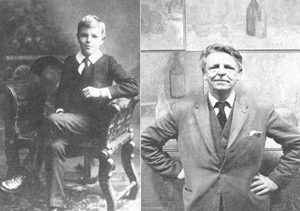| Adrian Stokes - aesthete, critic, painter and poet - was born on 27 October 1902 in Radnor Place, Bayswater. |  |
A D R I A N S T O K E S
PREFACE
The Affirmation of the Eye
by Stephen Kite
page 1 of 8 |
| Adrian Stokes - aesthete, critic, painter and poet - was born on 27 October 1902 in Radnor Place, Bayswater. |  |
A life of patient enquiry
produced over twenty critical books and numerous papers; paintings of a mysterious
iridescence that, he maintained, "project an armature of the architectural effects
that mean everything to me" 1 and in his last years, poetry with a personal, astringent rhythm. A letter to
the Times Literary Supplement in 1965, signed by eighteen prominent thinkers and artists -
including Coldstream, Moore, Hepworth and Wollheim - claimed Adrian Stokes as amongst
"the most original and creative .... writers on art." 2 Stokes's writings sustain the English aesthetic tradition of Pater and
Ruskin, illumined by a profound sensibility to the consolations of art and architecture,
and the insights given by psychoanalysis. This site aims to widen knowledge of this
remarkable body of work. To those to whom Stokes's work is a rumour it offers an
introduction to its range and diversity. To scholars of Stokes and researchers into
aesthetics, the arts and related fields it will foster inquiry and inter-cultural exchange
at the interfaces between the image and the word. It will also be a noticeboard to advise
of on-going research, recent papers, and related conferences and exhibitions. This preface
to the site adumbrates some of the themes that inform the work. These may be followed up
further in Richard Wollheim's article, Richard Read's biographical outline, in the works
themselves (see Bibliography) , in the paintings (see Tate Gallery site) , in the
recordings, and in related papers.
Adrian Stokes died, some two miles north of his birthplace, at
Church Row, Hampstead on the 15 December 1972. In his last published lecture - The
Future and Art - he acknowledged himself as a "Londoner" yet expressed
life-long anxiety with its urban environment. He wrote: "as for the Edwardian
buildings in my childhood, I can truly say I experienced from them the shamelessness of
pretence as if death were smug." 3 The restorative impulse that motivated his writing and art was a response
to the negative topos of the Hyde Park urban landscape of his youth and
adolescence.